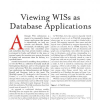Free Online Productivity Tools
i2Speak
i2Symbol
i2OCR
iTex2Img
iWeb2Print
iWeb2Shot
i2Type
iPdf2Split
iPdf2Merge
i2Bopomofo
i2Arabic
i2Style
i2Image
i2PDF
iLatex2Rtf
Sci2ools
CACM
1998
1998
Viewing WISs as Database Applications
abstraction for modeling these problems is to view the Web as a collection of (usually small and heterogeneous) databases, and to view programs that extract and process Web data automatically as database applications (see Balasubramanian and Bashian; Kambil and Ginsburg, both in this issue). The WebOQL system [2], developed at the University of Toronto, is a tool for building the software layer through which such programs can view Web data in a uniform, convenient format and can effectively manipulate it using a declarative query language. To accomplish this uniformity, WebOQL synthesizes ideas from several areas of research [1, 3–5]. As opposed to traditional database models, WebOQL does not require the a priori definition of a schema for the data to be queried, thus making it possible to model irregularly structured data or data with a structure that is only partially known and making it easy to accommodate different kinds of data, such as structured documents, relational tables, a...
| Added | 21 Dec 2010 |
| Updated | 21 Dec 2010 |
| Type | Journal |
| Year | 1998 |
| Where | CACM |
| Authors | Gustavo O. Arocena, Alberto O. Mendelzon |
Comments (0)

